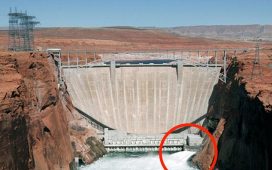Planet-wide storms could have caused Mars’s water supply to disappear by launching it into space on a 50-mile-high dust tower
- Two new studies suggest dust storms might have emptied Mars’s surface
- 50-mile-high dust towers form during storms and lift vapor into the atmosphere
- These storms envelop the entire surface of the planet every ten or so years
This month, NASA announced the results of two new papers that suggest giant dust towers on Mars could be responsible for emptying the planet’s one ample surface water stores.
This two new studies looked at atmospheric data from 2018, when dust-storms enveloped the entire planet and forced NASA’s Opportunity rover mission to come to an unexpected end.
During these storms, researchers observed enormous dust towers, as wide as Rhode Island and over 50 miles high, feeding gas vapors and dirt particles high into the Martian atmosphere

New research shows that giant dust towers that form during planet-wide storms on Mars might have helped drain the planet’s surface stores of water
Researchers posit that these towers could have launched water vapor from Mars’s surface into the planet’s upper atmosphere, where intense solar radiation could have caused the vapor to separate from the dust particles it had bonded with.
Over a prolonged period of time, planet-wide dust towers such as those observed in 2018 could have helped empty out all the water reserves from the planet’s surface.
Scientists say the kinds of planet-wide storms that produce these giant dust towers happen every ten years or so on Mars.
‘Normally the dust would fall down in a day or so,’ Hampton University’s Nicholas Heavens told NASA.
‘But during a global storm, dust towers are renewed continuously for weeks.’

Heavens described the dust towers as ‘space elevators,’ which have been observed to transport a wide range of different material into the Martian atmosphere.
Heavens previous work showed how Mars’s dust storms could lift vapor and gas particles into Mars’s upper atmosphere, which helps explain the periodic formation of small white clouds that are sometimes visible above the planet’s surface.
With these storms periodically building into planet-wide swarms instead of isolated occurrences could help explain how Mars lost what appears to have once been a substantial amount of surface water at a number of different regions.
‘Global dust storms are really unusual,’ David Kass from NASA’s Jet Propulsion Laboratory, said.
‘We really don’t have anything like this on the Earth, where the entire planet’s weather changes for several months. ‘














